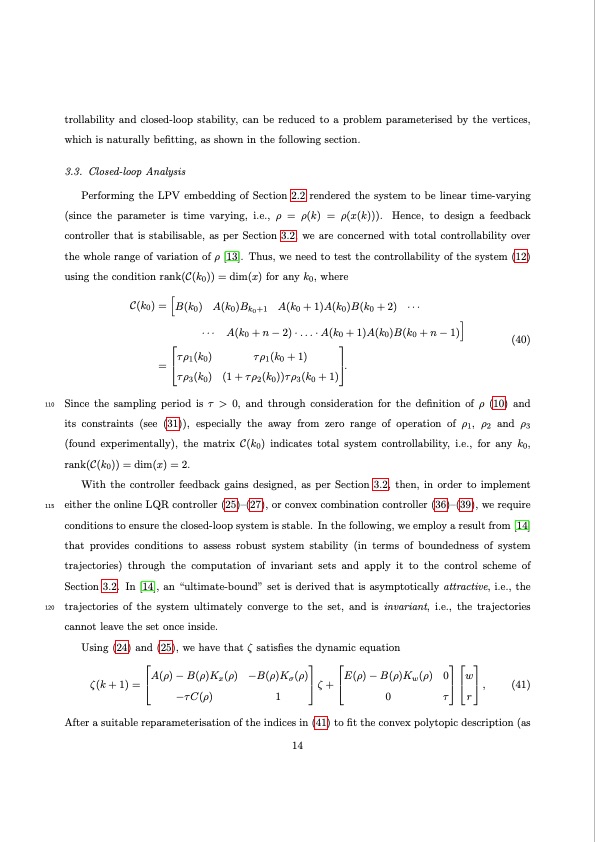
PDF Publication Title:
Text from PDF Page: 014
trollability and closed-loop stability, can be reduced to a problem parameterised by the vertices, which is naturally befitting, as shown in the following section. 3.3. Closed-loop Analysis Performing the LPV embedding of Section 2.2 rendered the system to be linear time-varying (since the parameter is time varying, i.e., ρ = ρ(k) = ρ(x(k))). Hence, to design a feedback controller that is stabilisable, as per Section 3.2, we are concerned with total controllability over the whole range of variation of ρ [13]. Thus, we need to test the controllability of the system (12) using the condition rank(C(k0)) = dim(x) for any k0, where C(k0) = B(k0) A(k0)Bk0+1 A(k0 + 1)A(k0)B(k0 + 2) · · · ··· A(k0 +n−2)·...·A(k0 +1)A(k0)B(k0 +n−1) = τρ1(k0) τρ1(k0+1) . τρ3(k0) (1 + τρ2(k0))τρ3(k0 + 1) (40) 110 Since the sampling period is τ > 0, and through consideration for the definition of ρ (10) and its constraints (see (31)), especially the away from zero range of operation of ρ1, ρ2 and ρ3 (found experimentally), the matrix C(k0) indicates total system controllability, i.e., for any k0, rank(C(k0)) = dim(x) = 2. With the controller feedback gains designed, as per Section 3.2, then, in order to implement 115 either the online LQR controller (25)–(27), or convex combination controller (36)–(39), we require conditions to ensure the closed-loop system is stable. In the following, we employ a result from [14] that provides conditions to assess robust system stability (in terms of boundedness of system trajectories) through the computation of invariant sets and apply it to the control scheme of Section 3.2. In [14], an “ultimate-bound” set is derived that is asymptotically attractive, i.e., the 120 trajectories of the system ultimately converge to the set, and is invariant, i.e., the trajectories cannot leave the set once inside. Using (24) and (25), we have that ζ satisfies the dynamic equation ζ(k + 1) = A(ρ) − B(ρ)Kx(ρ) −B(ρ)Kσ(ρ) ζ + E(ρ) − B(ρ)Kw(ρ) 0 w , (41) −τC(ρ)1 0τr After a suitable reparameterisation of the indices in (41) to fit the convex polytopic description (as 14 PDF Image | Electrolyte Flow Rate Control Vanadium Redox Flow Batteries

PDF Search Title:
Electrolyte Flow Rate Control Vanadium Redox Flow BatteriesOriginal File Name Searched:
2201-12812.pdfDIY PDF Search: Google It | Yahoo | Bing
Salgenx Redox Flow Battery Technology: Salt water flow battery technology with low cost and great energy density that can be used for power storage and thermal storage. Let us de-risk your production using our license. Our aqueous flow battery is less cost than Tesla Megapack and available faster. Redox flow battery. No membrane needed like with Vanadium, or Bromine. Salgenx flow battery
| CONTACT TEL: 608-238-6001 Email: greg@salgenx.com | RSS | AMP |